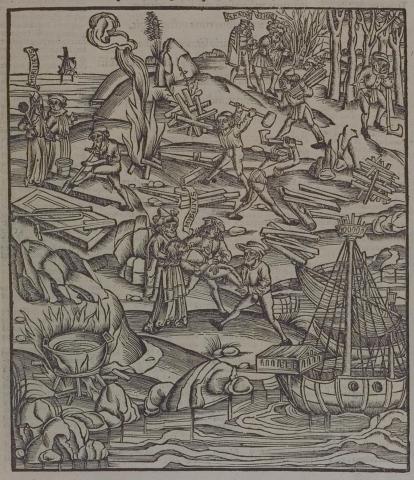Annotations
The men of Aeneas prepare a funeral for Misenus (156-235), while in the upper right corner, Aeneas and Achates enter the grove to seek the golden bough that Aeneas needs in order to enter the underworld (183-211). Men cut down trees and chop logs to build a funeral pyre for the tomb of their comrade (176-84). Another digs a grave. There are multiple piles of chopped wood, so it is not immediately clear which one is intended as the funeral pyre. It would make sense that the lit fire would be the pyre, but the one next to it is surrounded by foliage, which is mentioned by Vergil in line 215. In the lower left, a cauldron of water is warmed in order to wash and anoint the body (218-9). Corynaeus [Chorineus] stands in the upper left corner, next to the grave, ready to collect the bones from the funeral pyre and place them in an urn (228). The oar and trumpet of Misenus lie on top of the tomb lid, ready to be placed in the tomb with the urn (232-6). (Katy Purington)
Woodcut illustration from the “Strasbourg Vergil,” edited by Sebastian Brant: Publii Virgilii Maronis Opera cum quinque vulgatis commentariis expolitissimisque figuris atque imaginibus nuper per Sebastianum Brant superadditis (Strasbourg: Johannis Grieninger, 1502), fol. 260r, executed by an anonymous engraver under the direction of Brant.


Sebastian Brant (1458-1521) was a humanist scholar of many competencies. Trained in classics and law at the University of Basel, Brant later lectured in jurisprudence there and practiced law in his native city of Strasbourg. While his satirical poem Das Narrenschiff won him considerable standing as a writer, his role in the transmission of Virgil to the Renaissance was at least as important. In 1502 he and Strasbourg printer Johannes Grüninger produced a major edition of Virgil’s works, along with Donatus’ Life and the commentaries of Servius, Landino, and Calderini, with more than two hundred woodcut illustrations. (Annabel Patterson)